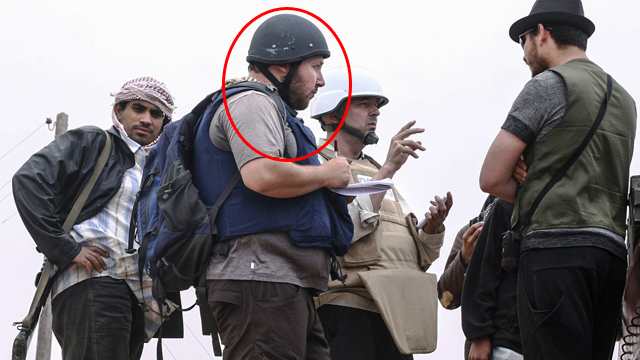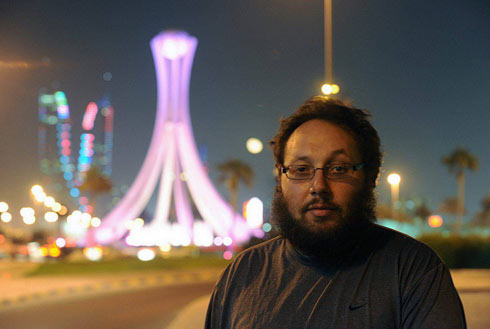
Steven Sotloff, the journalist beheaded by the Islamic State, was a dual Israel-US citizen and had even studied in Israel, it emerged Wednesday, the day after a video of his brutal murder was aired online.
The White House says it has determined that the video showing his killing is authentic, after Islamic State extremists released the video showing Sotloff's beheading on Tuesday. It comes two weeks after the militants released a video showing the killing of James Foley, another American journalist.
Sotloff made aliyah and studied at the IDC some 10 years ago. After his capture in Syria, it seems any connection to Israel was deleted from his online presence in a bid to prevent the information from reaching his captors.
National Security Council spokeswoman Caitlin Hayden announced the US intelligence community's assessment of the video in a statement Wednesday.
Colleagues and acquaintances remembered Sotloff as a generous man fascinated by journalism and the changes gripping the Middle East, and determined to tell stories from the perspective of average people, not army movements on the battlefield.
A friend who was with Sotloff in captivity told Ynet's sister-print publication Yedioth Aharonoth that Sotloff was Jewish - a fact he hid from his captors - and even managed to observe the Yom Kippur fast while in Islamic State captivity.
"He told them he was sick and didn’t want to eat, even though we were served eggs that day," the friend said. "He used to pray secretly in the direction of Jerusalem. He would see in which direction (his Muslim captors) were praying and then adjust the angle."
Others recalled his professionalism: "He struck me as a very, very decent guy ... he wasn't chasing headlines, he wasn't hyping a pitch," said James Denton, publisher and editor of the Washington-based journal World Affairs, one of several publications that hired him for freelance work. Others included TIME and Foreign Policy.
"He wanted to get the story, he wanted to peel away the layers," said Denton, who met Sotloff over coffee in Washington in May 2013, and published two of his dispatches from Cairo the following July.
'An honorable man'
Sotloff, a 31-year-old Miami-area native who freelanced for Time and Foreign Policy magazines, vanished in Syria in August 2013 and was not seen again until he appeared in a video released last month that showed Foley's beheading.
Dressed in an orange jumpsuit against an arid Syrian landscape, Sotloff was threatened in that video with death unless the US stopped airstrikes on the Islamic State.
At Sotloff's parents' home in Pinecrest, Florida., two police vehicles blocked the driveway Tuesday, and officers advised journalists to stay away. Friends of the family could be seen coming and going.
A spokesman for the family, Barak Barfi, said in a brief statement that the family “knows of this horrific tragedy and is grieving privately,”
"Everyone's been concerned. Everyone is grieving," neighbor Pepe Cazas said. "It's terrible. I've been praying for him."
Last week, Sotloff's mother, Shirley Sotloff, pleaded with his captors for mercy, saying in a video that her son was "an innocent journalist" and "an honorable man" who "has always tried to help the weak."
Sotloff grew up in the Miami area, and graduated from Kimball Union Academy, a prep school in New Hampshire. He was also a student at Temple Beth Am Day School in Florida.
As a student at Kimball, Sotloff "developed a passion for reporting and writing, a gift that he shared with people around the world, and this unthinkable act of terror has taken him from us far too soon," New Hampshire Gov. Maggie Hassan said in a statement.
Sotloff then attended the University of Central Florida, which said he majored in journalism from 2002 to 2004, but apparently left without graduating.
Just how Sotloff made his way from Florida to Middle East hotspots is not clear. He published articles from Syria, Egypt and Libya in a variety of publications. Several focus on the plight of ordinary people in war-torn places.
One individual familiar with the case said the family's theory had been that Sotloff was grabbed by a criminal gang, and later transferred or "sold" to Islamic State. This could not be confirmed by his family, which declined interview requests.
Preparing for the trip to Syria, Sotloff reportedly asked a fellow reporter in June 2013: "What type of lawlessness in Aleppo? Should I keep my eyes open for anything regarding safety?"
"Can you meet with ISI," he asked, using an earlier acronym for Islamic State. "And the quality of life? Is there still plenty of food available? Gas?"
In a statement, Foreign Policy magazine called him a "brave and talented journalist" whose reporting "showed a deep concern for the civilians caught in the middle of a brutal war."
Time editor Nancy Gibbs said Sotloff "gave his life so readers would have access to information from some of the most dangerous places in the world."
The Associated Press and Reuters contributed to this report

















